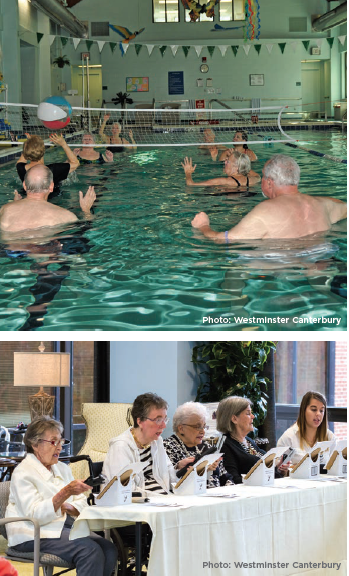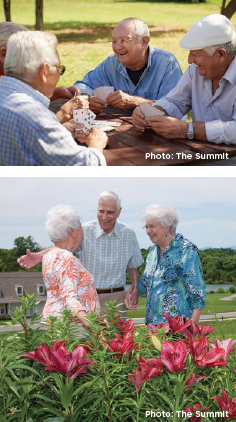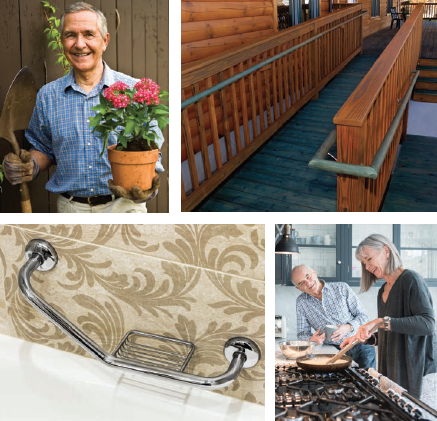Living into Retirement


At the turn of the 20th century, most retired people expected to remain in their homes throughout the aging process, surrounded by their families, friends and neighbors. In 1900, the average life expectancy was 49 years old and the “senior citizens” of the day made up less than 4 percent of the total population. Fast forward to 2017, and the definition of aging itself seems to have radically changed. It’s hard to imagine most 49-year-olds rocking away their golden years in a rocking chair on the front porch! People work longer and live longer—and it is only upon turning 65 that most people actually define themselves as “senior.” This is the age that US citizens may apply for Medicare, and it’s the most common age of retirement. People who are turning 65 this year were born in 1952, putting them squarely in the “Baby Boomer” generation; at over 75 million, they were until recently the largest population America had produced
(the Millenials recently took first place), and now they range in age from mid-50s to mid-70s.
 As they enter retirement, this trail-blazing generation has redefined aging, not only pushing off the designation of “senior citizen,” but also reinventing the whole idea of how they age—and where they will do it. Though Baby Boomers’ grandparents largely stayed put, the Baby Boomers themselves have demanded other choices. This can be attributed in part to the fact that people live much longer than they did in 1900; their plans for post-retirement aging have expanded from a few years to several decades. Retirement is now a stage of life that lasts long enough to require careful and realistic planning.
As they enter retirement, this trail-blazing generation has redefined aging, not only pushing off the designation of “senior citizen,” but also reinventing the whole idea of how they age—and where they will do it. Though Baby Boomers’ grandparents largely stayed put, the Baby Boomers themselves have demanded other choices. This can be attributed in part to the fact that people live much longer than they did in 1900; their plans for post-retirement aging have expanded from a few years to several decades. Retirement is now a stage of life that lasts long enough to require careful and realistic planning.
To that end, many of today’s adults of retirement age need to put careful thought into how they will spend this stage of their lives. Planning ahead for these years means defining where and how you want to live, and, at the same time, being realistic about the inevitability of aging and the complications and uncertainties this can engender. Thankfully there are many excellent options, most of which fall into two categories: Retirees can join communities that provide a full or partial continuum of care, known most commonly as Continuing Care Retirement Communities (CCRCs); or they elect to “age in place,” remaining home (though “home” could also be the home of their extended family) and making whatever structural modifications are needed along the way.
 Continuing Care Retirement Communities
Continuing Care Retirement Communities
“I’ll never go into a ‘home.’” This was a near-constant mantra from my elderly grandfather. Almost ten years a widower, he was proud of his independence and he never wanted to leave his tidy little Cape Cod. As he moved into his 90s (his 90s!) however, things began to change. He hired cadres of people to maintain his house and yard, but his vision was failing, and so was his manual dexterity, and it became hard for him to take care of himself. He could no longer drive and no one came to visit. With failing eyesight and hearing, he couldn’t watch TV, talk on the phone, or use his beloved computer. His world began to shrink exponentially, and he became lonely, isolated and perhaps depressed. But at least he hadn’t been put into a “home,” as he called it, envisioning a sad, dim nursing home where elderly people were parked in wheelchairs and forgotten. His fear of such a place was palpable. He had his pride, and even if his quality of life was dwindling, he was determined to hold out … until of course, he couldn’t.
A relatively mild cardiac event landed him in a small continuing care community that offered rehabilitation services as part of their full continuum of care. As he recovered, he began, as health permitted, to sample some of the activities offered in this community. A few weeks into his stay, he perked up like a wilted houseplant given water and care. He played bingo, ordered take-out, participated in musical events, but most of all, he made connections with several old friends and acquaintances he’d lost touch with over the years. All those years isolated in his house, he’d assumed he was all alone, but as he joyfully confided one visit soon after moving in, “It turns out, my friends were all here!”
 Today’s CCRCs couldn’t be farther from the “home” my grandfather feared. To begin, they often resemble luxury resorts, complete with indoor swimming pools, gyms and fine dining—but they also offer a full continuum of care, from practically none to 24-hour skilled nursing, all on the same campus. The first stage, the “independent living” step on the continuum, is often just that: Residents live in apartments, condos, or even freestanding houses complete with full kitchens, 1-3 bedrooms, laundry, balconies and even sometimes small gardens and patios. The second stage is “assisted living.” This stage offers step-up care for people who need a little extra help completing daily tasks but who do not require full-time care. The third step in the continuum is “long-term care,” which provides round-the-clock assistance, skilled nursing, and even sometimes memory care for those struggling with Alzheimer’s Disease and dementia-related illnesses. Often these communities also have a separate, short-term rehabilitation unit for people who are recovering from surgery or other illnesses. Seniors who choose to join an independent living community are encouraged to do so while they are still young enough to enjoy the many amenities offered at every level of care. Once they have joined, seniors can transition, as needed, through the different levels of care all within the same campus. The advantages of this are obvious: Seniors can stay onsite for the rest of their lives with no disruptions of their social and care networks. They also have peace of mind—and so do their families—knowing that as they age, their needs will be met.
Today’s CCRCs couldn’t be farther from the “home” my grandfather feared. To begin, they often resemble luxury resorts, complete with indoor swimming pools, gyms and fine dining—but they also offer a full continuum of care, from practically none to 24-hour skilled nursing, all on the same campus. The first stage, the “independent living” step on the continuum, is often just that: Residents live in apartments, condos, or even freestanding houses complete with full kitchens, 1-3 bedrooms, laundry, balconies and even sometimes small gardens and patios. The second stage is “assisted living.” This stage offers step-up care for people who need a little extra help completing daily tasks but who do not require full-time care. The third step in the continuum is “long-term care,” which provides round-the-clock assistance, skilled nursing, and even sometimes memory care for those struggling with Alzheimer’s Disease and dementia-related illnesses. Often these communities also have a separate, short-term rehabilitation unit for people who are recovering from surgery or other illnesses. Seniors who choose to join an independent living community are encouraged to do so while they are still young enough to enjoy the many amenities offered at every level of care. Once they have joined, seniors can transition, as needed, through the different levels of care all within the same campus. The advantages of this are obvious: Seniors can stay onsite for the rest of their lives with no disruptions of their social and care networks. They also have peace of mind—and so do their families—knowing that as they age, their needs will be met.
Central Virginia’s mild climate and beautiful mountains attract many retirees, who, as they age, begin to look for ways to simplify their lives and have more time for the things they enjoy. At Westminster Canterbury of Lynchburg, Debbie Callahan, vice president of marketing and development, explains that seniors are often relieved to find that they can give up all the exhausting and expensive details of running their households: housekeeping, yard maintenance, utilities, and even cooking, and consolidate everything. “People really do blossom in communities like this,” she says. “We offer so many opportunities for interaction and socialization, for exercise and health, and for learning and volunteering, that often people do feel energized. It’s like they have a whole new lease on life.” Westminster Canterbury of Lynchburg offers residents health care across the continuum for the rest of their lives; their residents pay a fee up front based on the size of accommodation they choose (with a choice between several luxury apartment models and freestanding houses), and then a monthly fee, which includes rent, utilities, maintenance and housekeeping, scheduled transportation, on-staff nursing care, urgent response and 24-hour security, not to mention access to all the amenities—and this fee stays nearly the same no matter how much care is needed. The amenities are impressive: acres of walking trails, gourmet dining, beauty and barber shops, craft and art studios, game and billiard rooms, and a health center. Callahan cites the popularity of the community’s wellness classes—particularly the water aerobics, and the “Senior Symposium” which allows residents to take Lynchburg College classes. “I think older adults—and their families—love Westminster Canterbury because they get a chance to simplify all the little details that get so hard to keep track of,” Callahan explains. “Here, they have all the services they need under one roof. This frees them up to invest their time in activities they enjoy, be that fitness, volunteering, socializing, or learning new things.”
 CCRCs come in many shapes and sizes, but the one thing they usually have in common is a maintenance–free lifestyle paired with comprehensive care across the health continuum. For seniors looking for the peace of mind of continuum of care, but prefer more of an à la carte approach in which you pay only for the services you or your partner/spouse use, The Summit is another great local alternative. Offering choices of apartment living or garden homes ranging from studios with 732 square feet to over 1800 square feet, The Summit charges an entry fee based on the size and type of dwelling chosen, but their services are all fee-for-service. The Summit partners with Centra, who provides on-site medical care to residents. According to Brenda Dixon, marketing director at The Summit, “We have the best of both worlds here. We have excellent health care for peace of mind, a beautiful 143-acre campus with lots of amenities, all set within the walkable community of Wyndhurst.” Residents at The Summit use the local YMCA which has dozens of wellness classes, and they enjoy the dining options onsite as well as in those in Wyndhurst which are an easy walk away. “People choose independent living communities for the lifestyle,” explains Dixon. “It takes the surprise and guesswork out of the next step. It’s amazing how many people get here and say, ‘I should have done this sooner!’”
CCRCs come in many shapes and sizes, but the one thing they usually have in common is a maintenance–free lifestyle paired with comprehensive care across the health continuum. For seniors looking for the peace of mind of continuum of care, but prefer more of an à la carte approach in which you pay only for the services you or your partner/spouse use, The Summit is another great local alternative. Offering choices of apartment living or garden homes ranging from studios with 732 square feet to over 1800 square feet, The Summit charges an entry fee based on the size and type of dwelling chosen, but their services are all fee-for-service. The Summit partners with Centra, who provides on-site medical care to residents. According to Brenda Dixon, marketing director at The Summit, “We have the best of both worlds here. We have excellent health care for peace of mind, a beautiful 143-acre campus with lots of amenities, all set within the walkable community of Wyndhurst.” Residents at The Summit use the local YMCA which has dozens of wellness classes, and they enjoy the dining options onsite as well as in those in Wyndhurst which are an easy walk away. “People choose independent living communities for the lifestyle,” explains Dixon. “It takes the surprise and guesswork out of the next step. It’s amazing how many people get here and say, ‘I should have done this sooner!’”
While retirement communities like The Summit or Westminster Canterbury do offer predictability and stability for retirees entering the next stage of life, there are some things to consider: First, planning is key. Financial planning is a must. Whether utilizing health or long term care insurance, Medicare, or personal savings, you will need to find a path that fits your individual financial picture. Thankfully most retirement communities have experts on staff who can help clients chart the best path.
Another consideration is the transition itself. Moving is always stressful, but often moving to a retirement community means leaving a long-time home, neighborhood or community, and often it also means significant downsizing. Most seniors feel that with their children grown, they no longer need the big house with many bedrooms, but if they are moving to a cottage or an apartment within a retirement community, this will usually necessitate some serious thought about what to do with all the “stuff” that won’t be used and probably won’t fit into the new location. According to Callahan and Dixon, this can be an emotional experience, made much easier if it is carefully planned in advance, rather than forced upon a person because of a health emergency. They recommend that potential residents take time to earmark the furniture and possessions that they want to bring along to their new apartment or cottage, and then distribute the remainder amongst their family members, donate to charity, or contact estate sale professionals. Fortunately, many retirement communities also have someone on hand to help with this process as well. “There’s no getting around the fact that it is hard to get rid of things,” says Callahan, “but once it’s done and you are moved into your beautiful new place? It feels fabulous.”

Aging in Place
The term “Aging in Place” can refer to a diverse category of alternatives for older adults who cannot or do not want to join a retirement community. These are most often seniors who choose to stay in their own home, contracting for the health, transportation and home maintenance they need. It can also refer to intergenerational living or other self-designed living arrangements.
Lacking the built-in continuum of care available to residents of CCRCs, retirees considering this option will need to budget and plan for their future years by essentially building their own plan for each stage of the aging process. Often this will mean making some big changes, even if you are planning to remain in the same home or move in with family. Though hiring help with tasks that can be challenging for older individuals, such as home maintenance or housekeeping, will certainly help, sometimes the home itself needs to be updated or modified to make everyday living easier.
Your first step should be to talk to an expert. The National Association of Homebuilders offers builders who qualify a Certified Aging In Place Specialist (CAPS) designation. Builders with this certification have received special training in the housing concerns for older individuals. Jeremy Smith of F&S Builders of Lynchburg, who serves the Central and Southwestern Virginia areas, proudly maintains a CAPS certification. “I strongly recommend that people who plan to age in place look for a builder with CAPS certification before starting a project with an eye to aging in place,” he says. “You need to be certain that a builder or contractor knows what he is doing with respect to the needs of older people and the requirements and building codes of specialized equipment such as elevators or walk-in tubs.” In business for over 30 years, F&S Builders has completed many renovation projects to help older individuals stay in their homes, from small improvements such as installing grab bars in bathrooms and widening doorways to accommodate wheelchairs, to large, full-scale renovations, such as two-story remodels with elevator installation, a custom roll-in tile shower, even an “endless pool” and outdoor landscaping designed to be accessible to homeowners with limited mobility.
 Renovating a home to accommodate older individuals, regardless of whether they will live alone or with extended family, is a challenging process because it involves projecting future needs and modifications as well immediate needs. “We are talking renovations that can cost anywhere from a couple of hundred dollars on up to tens of thousands, depending on the scale of the work,” explains Smith, “so you don’t want someone selling you stuff you won’t use.” Instead, he suggests asking yourself, “How will this make my life better?” For those considering renovations, he recommends an in-home evaluation with a professional who will discuss individual needs and most importantly, will help clients evaluate improvements. “You want someone who will help you decide what you will really use, day in and day out,” says Smith. “Someone who will help you maximize your dollar.”
Renovating a home to accommodate older individuals, regardless of whether they will live alone or with extended family, is a challenging process because it involves projecting future needs and modifications as well immediate needs. “We are talking renovations that can cost anywhere from a couple of hundred dollars on up to tens of thousands, depending on the scale of the work,” explains Smith, “so you don’t want someone selling you stuff you won’t use.” Instead, he suggests asking yourself, “How will this make my life better?” For those considering renovations, he recommends an in-home evaluation with a professional who will discuss individual needs and most importantly, will help clients evaluate improvements. “You want someone who will help you decide what you will really use, day in and day out,” says Smith. “Someone who will help you maximize your dollar.”
Orchestrating a safe home environment will go a long way to ensure that individuals or couples can continue to live in their own homes, but sometimes even the healthiest and most active seniors have health issues that restrict their ability to care for themselves and may require medical care or rehabilitation. It is far better to have a plan in place for this ahead of time, rather than waiting for a health crisis to occur. There are several options for home health care available today; in fact, many communities have rehabilitation wings with skilled nursing care where even “non-resident” seniors can recover from an injury or illness. Alternately, many of these same organizations have home-health extensions such as Westminster Canterbury’s “Senior Independence,” which offers home- and community-based services designed to help older adults remain in their own homes or in the homes of their families.
The idea of spending your “golden years” in a rocker on the front porch is over … but only if you want it to be. As a retiree, you could be taking college courses, playing golf, teaching children to read, or learning to paint. You could be living with your extended family, or in the same home you’ve always lived in … or in a swanky new cottage or apartment surrounded by new friends. Whether you choose to join a retirement community, or age in place, one thing you won’t be short on is options. Aging is a universal eventuality for every person, young or not-so-young. It pays to start weighing the many available choices, so that when you do reach that stage, you will be in control. With foresight, practicality and creativity, options for how to spend retirement are both exciting and full of promise.
aging, retirement, senior issue, senior living, seniors, the summit, Westminster Canterbury






